Yellowstone’s Spring Birding Hotspots
Birding in Yellowstone
Human visitors aren’t the only ones who flock to Yellowstone from all over the world. Over 150 species of birds return to Yellowstone each year to mate and raise young. Some, like red wing blackbirds, ducks, robins, swans, geese, and red-tailed hawks winter within the region and are the first to return. Others—neotropical migratory birds like warblers, flycatchers, tanagers, swallows, loons, peregrine falcons, osprey, and others—travel from Mexico, Central America, and South America on an airborne path called the Central Flyway through Texas and along the Rocky Mountains on their return to Yellowstone.
By June, a teeming population of breeding birds occupy cliff ledges, tree limbs, trunk cavities, and treetops in the park. Yellowstone is nirvana for bird parents, where a variety of elevations and habitat types provide ample home for a diversity of birds. The cornucopia of food is seemingly endless: insects, small mammals, reptiles, amphibians, and fish abound.
Spring is an exciting time in the park, as waves of returning birds bring color and life back to the ecosystem. Here’s where to catch Yellowstone’s spring birding action:
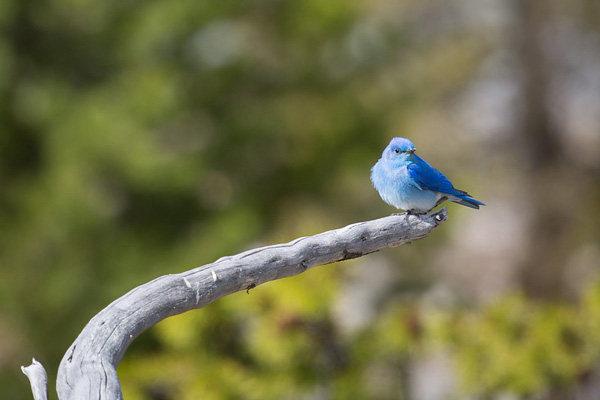
Mountain Bluebird
Swan Lake Flats
This high elevation valley rimmed by the Gallatin Mountain range is a haven for mountain bluebirds and sandhill cranes, who forage for insects and other small creatures in the sagebrush and grasses. Swan Lake is sometimes a nesting ground for trumpeter swans and a good place to see colorful waterfowl such as redhead, American widgeon, canvasback, and ring-necked ducks.
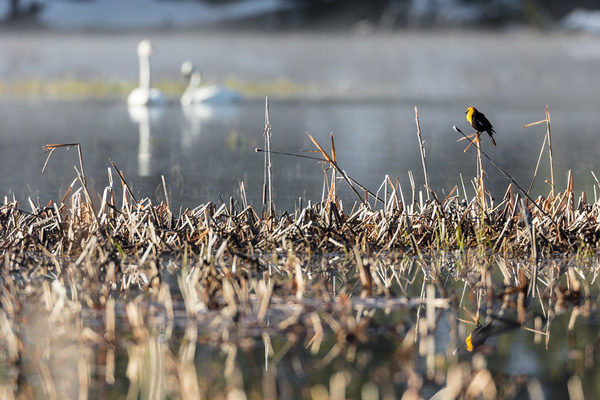
Yellow-Headed Blackbird and Trumpeter Swans
Floating Island Lake
This small pond west of Tower Junction is a wonderful spring birding spot. The bright flash of yellow-headed blackbirds can be seen among the cattails and reeds on the shoreline, as their raspy, dissonant calls pierce the air. On the lake, male ruddy ducks sporting their bright blue bills and rusty-colored feathers can be seen competing for female attention. American coots are in abundance here and are fun to watch as they aggressively chase each other around the lake, tails up, and necks out.
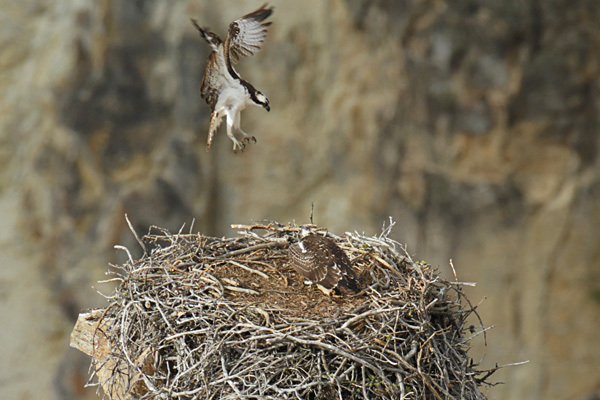
Osprey returning to nest
Calcite Springs to Tower Fall along the Yellowstone River
The area between Calcite Springs and Tower Fall is another Yellowstone birding hotspot. The towering cliff walls above the Yellowstone River are a haven for nesting peregrine falcons, ravens, and osprey. Violet-green swallows and white-throated swifts gracefully dip and dive, as the falcons hunt them from above. Osprey dive for trout in the river. You might even spot great horned owls, who have been known to nest in this area.
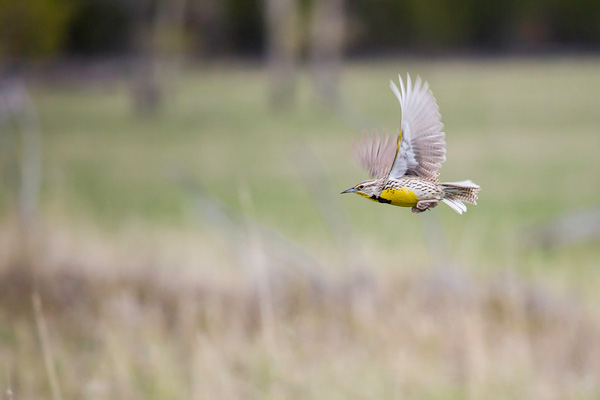
Western Meadowlark
Lamar and Hayden Valleys
The sagebrush habitats of the Lamar and Hayden Valleys are great spots to see sage thrashers, Brewer’s sparrows, meadowlarks, and savannah sparrows. Overhead, kestrels hover over the open valleys in search of insects, small rodents, and snakes, as do Swainson’s, red-tailed, and other hawks. In marshy areas such as the ephemeral ponds that dot the valley landscape, Northern harriers—also known as marsh hawks—can be seen flying low above the ground. Look for a variety of warbler species—such as Wilson’s, yellow-rumped, and Townsend’s warblers—along wet willowy areas.
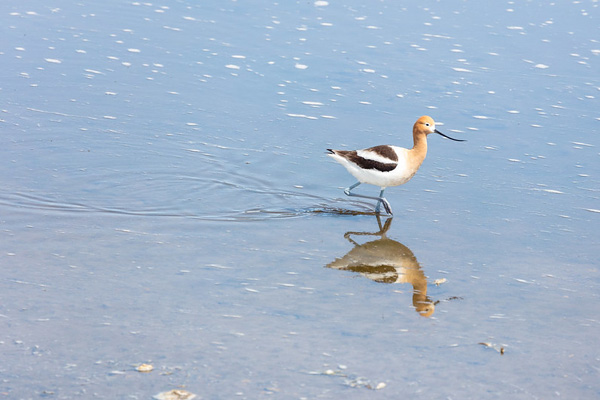
Avocet
Pelican Creek and the Yellowstone River
Wetland areas such as Pelican Creek along Yellowstone Lake are great places to see wading birds such as avocets, black-necked stilts, and the occasional great blue heron, as well as the water-walking display of Western grebes. You might even see a muskrat or two swimming in the creek channels as the eerie flute-like notes of hermit and Swainson’s thrushes echo from the nearby forest. Trumpeter swans often float serenely by on the Yellowstone River south of Canyon Village.
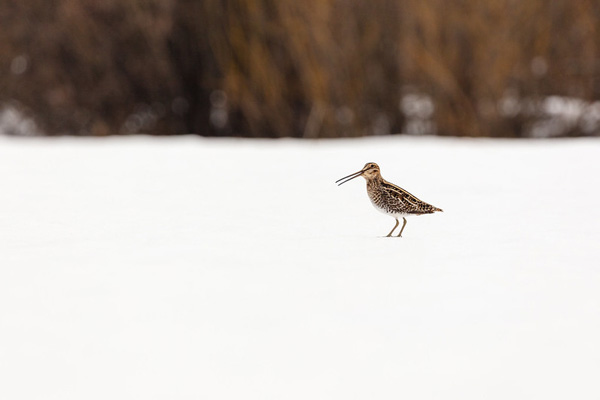
Wilson’s Snipe
Blacktail Ponds
Morning at this set of ponds, left behind by a long-gone glacier, dawns with an avian cacophony: the “cheerilee, cherri-ups” of American robins, the “conkarees” of lustful red-winged blackbirds singing from bending cattails, the “kwaawks” of territorial ravens and the pulsating, chortling keening of bald eagles. It’s not uncommon to hear the winnowing display call of the Wilson’s snipe, and see pied-billed grebes sneaking about the water’s edge, along with American widgeon, lesser scaup, and gadwall ducks.
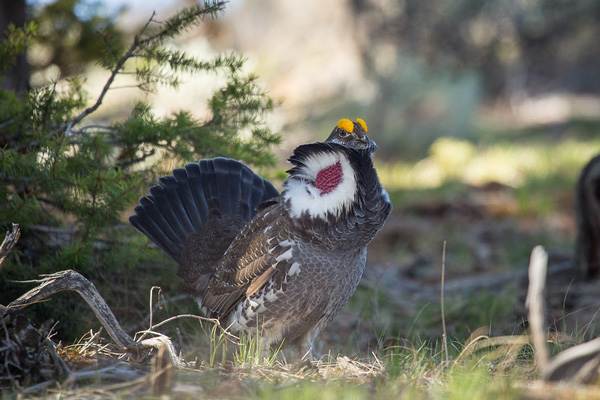
Dusky Grouse
Beaver Ponds
If you happen to take a hike in a mixed meadow and woodland area such as the Beaver Ponds Trail in Mammoth, you may hear the low hoot of the male dusky grouse or the drumming of a ruffed grouse as they perform their mating display. Take some time to observe an aspen stand, where you’re likely to see mountain bluebirds and northern flickers busily bringing food back to their nests in tree cavities.
Birding Tips
When birding, don’t be too hasty to pick up your binoculars! Let your ears be the guide by listening for the chips, weeps, hoots and croaks of area birds to then guide your eyes to the spot. Look for movement first, then put your binoculars up. To make sure you find the bird you were looking at, fix your gaze on the spot of interest (this is very helpful for picking out moving things against a broad open blue sky) and then put the binoculars ‘in the way,’ rather than ‘looking into’ the binoculars and then trying to find your way to your subject. You may need to practice a little bit before you come to the park, but it will sure be worth it!
Bird apps like the Merlin Bird ID app, and Sibley’s e-guide to birds, can be helpful with identification, as they have visual identification tools, range maps, and calls and songs that you can listen to and compare with what you find out in the park.
While there is a lot of opportunity to delight in Yellowstone’s birds, remember that the rearing of young in Yellowstone is not an easy task for any bird. Staying 25 yards from park wildlife and 100 yards from nesting birds gives them the best chance at survival to return the following spring.
Jenny Golding is the founding editor of A Yellowstone Life and writes from her home at the north entrance to Yellowstone in Gardiner, Montana.
For A World of Unforgettable Experiences® available from Xanterra Travel Collection® and our sister companies, visit xanterra.com.
Want to experience Yellowstone in-depth? See what makes Yellowstone National Park a great place to work for a season or longer!